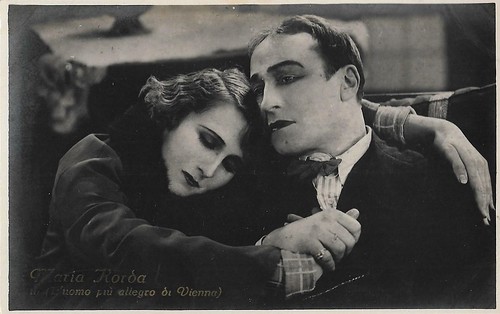
Italian postcard by Ed. A. Traldi, Milano. Photo: S.A.I.C. Ruggero Ruggeri in L'uomo più allegro di Vienna/The Most Cheerful Man in Vienna (Amleto Palermi, 1925).

Italian postcard by Ed. A. Traldi, Milano. photo: S.A.I.C. / Palermi Films. Maria Corda and Victor Varconi in L'uomo più allegro di Vienna (Amleto Palermi, 1925). Caption: Il Congedo/The Goodbye.

Italian postcard by G.B. Falci, Milano, no. 345. Photo: La Fotominio / Fotolux / Palermi Films. Maria Corda and Victor Varconi in L'uomo più allegro di Vienna/The Most Cheerful Man in Vienna (Amleto Palermi, 1925).
Quite moralistic but also modern
The plot of L'uomo più allegro di Vienna/The Most Cheerful Man in Vienna (Amleto Palermi, 1925) is quite moralistic but also modern. Katy, a young girl (Maria Corda) is easily attracted to a fancy life by a gigolo, William (Victor Varconi). Her father Max Bluck (Ruggero Ruggeri), a happy-go-lucky leader of a jazz band, energetically manages to subtract her from danger, even if all the relatives think he is a good-for-nothing.
Hungarian Maria Corda (1898-1975) was an immensely popular star of the silent cinema of Austria and Germany. The pretty, blonde actress was a queen of the popular epic spectacles of the 1920s, which were often directed by her husband, Alexander Korda.
Ruggero Ruggeri (1871-1953) was one the most important Italian stage actors of the first half of the twentieth century, who often performed the plays by Pirandello. He did perform in films too, both in silent and sound films. Nowadays, he is best remembered as the voice of Jesus in the Don Camillo films.
Handsome Victor Varconi (1891–1976) was a highly successful matinee idol of the Hungarian-Austrian and German silent cinema in the 1910s and early 1920s. Later he was the first Hungarian actor to become a Hollywood star until the sound film completely altered the course of his career.
In addition to Corda, Ruggeri and Varconi, Gianna Terribili Gonzales played Katy's mother, Loulou. Cinematography was by Vittore Armenise, while art direction was by Nino Macarones and Vittorio Cafiero.

Italian postcard by G.B. Falci, Milano, no. 341. Photo: La Fotominio / Fotolux / Palermi Films. Maria Corda in L'uomo più allegro di Vienna/The Most Cheerful Man in Vienna (Amleto Palermi, 1925).

Italian postcard by G.B. Falci, Milano, no. 343. Photo: La Fotominio / Fotolux / Palermi Films. Maria Corda in L'uomo più allegro di Vienna/The Most Cheerful Man in Vienna (Amleto Palermi, 1925).

Italian postcard by G.B. Falci, Milano, no. 345. Photo: La Fotominio / Fotolux / Palermi Films. Maria Corda and Victor Varconi in L'uomo più allegro di Vienna/The Most Cheerful Man in Vienna (Amleto Palermi, 1925).

Italian postcard by G.B. Falci, Milano, no. 349. Photo: La Fotominio / Fotolux / Palermi Films. Maria Corda and Ruggero Ruggeri in L'uomo più allegro di Vienna/The Most Cheerful Man in Vienna (Amleto Palermi, 1925).
Set in the louche dens of Vienna with its brutish visitors
L'uomo più allegro di Vienna/The Most Cheerful Man in Vienna (Amleto Palermi, 1925) was produced by Palermi's company A. P. Films (Almeto Palermi Films), while S.A.I.C. distributed it. On 25 November 1925, the film had its premiere in Rome.
At the time, the Milanese journal La rassegna del teatro e del cinematografo wrote that the plot seemed like a modernised Rigoletto, as a very moral tale about a father who in vain tries to prevent his daughter from dishonour, and also commented that the story was not entirely innocent, set in the louche dens of Vienna with its brutish visitors. The journal concluded the film was like a true restaurant dish: good meat but with an indigestible sauce.
In addition, the Roman source Il Tevere wrote that the plot may have seemed sentimental and old hat, but Ruggero Ruggeri gave a modern, innovative performance to it, giving his character a life of its own, while Maria Corda was given ample space to excel side by side with him.
A print of L'uomo più allegro di Vienna/The Most Cheerful Man in Vienna was restored by the Cineteca del Friuli, Gemona (Italy), in collaboration with the Hungarian National Film Archive in Budapest.

Italian postcard by G.B. Falci, Milano, no. 402. Photo: La Fotominio. Gianna Terribili Gonzales as Loulou and Victor Varconi as William in L'uomo più allegro di Vienna/The Most Cheerful Man in Vienna (Amleto Palermi, 1925).

Italian postcard by G.B. Falci, Milano, no. 350. Photo: La Fotominio / Fotolux / Palermi Films. Maria Corda and Ruggero Ruggeri in L'uomo più allegro di Vienna/The Most Cheerful Man in Vienna (Amleto Palermi, 1925).

Italian postcard by G.B. Falci, Milano, no. 352. Photo: La Fotominio / Fotolux / Palermi Films. Maria Corda in L'uomo più allegro di Vienna/The Most Cheerful Man in Vienna (Amleto Palermi, 1925).

Italian postcard by G.B. Falci, Milano, no. 363. Photo: La Fotominio / Fotolux / Palermi Films. Maria Corda and Victor Varconi in L'uomo più allegro di Vienna/The Most Cheerful Man in Vienna (Amleto Palermi, 1925).
Sources: Vittorio Martinelli (Il cinema muto italiano, 1923-1931 - Italian), Cineteca del Friuli, and IMDb.
No comments:
Post a Comment